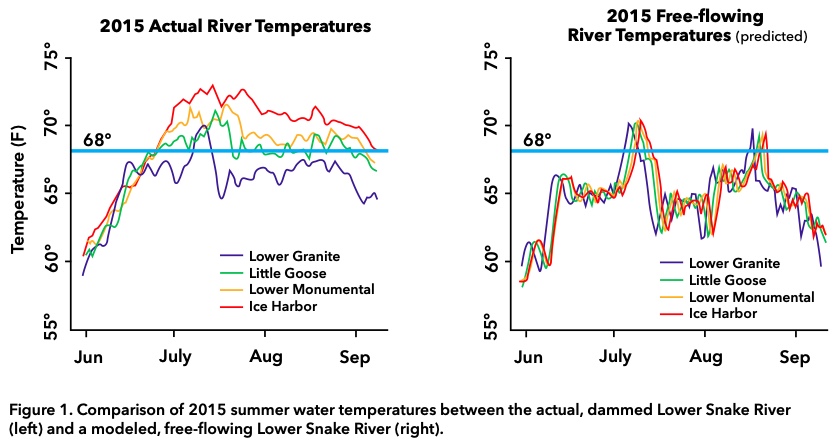forum
library
tutorial
contact

Groups Plan to Sue to Remove Snake River Dams
Over Hot Water Troubles for Salmon
by Courtney Flatt
Oregon Public Broadcasting, July 25, 2023
|
the film forum library tutorial contact |

|
Groups Plan to Sue to Remove Snake River Dams
by Courtney Flatt
|
The Corps and agricultural stakeholders have long argued
that only Congress can authorize removal of the dams
 Several conservation and fishing groups say the Snake River dams are making the river too hot for sockeye salmon. Now, they're planning to sue the federal government to remove the dams. But dam advocates say the move will make climate change -- and hot waters -- worse.
Several conservation and fishing groups say the Snake River dams are making the river too hot for sockeye salmon. Now, they're planning to sue the federal government to remove the dams. But dam advocates say the move will make climate change -- and hot waters -- worse.
When water temperatures spike above 68 degrees, adult salmon start to run into real trouble.
Columbia Riverkeeper, Idaho Rivers United, Idaho Conservation League and the Northwest Sportfishing Industry Association formally notified the U.S. Army Corps of Engineers of their intent to sue.
According to the groups, the dams on the Lower Snake River are creating conditions that are lethal for endangered sockeye salmon.
"These fish are hanging on by a thread as it is. If conditions get worse, they're extremely likely to go extinct," said Miles Johnson, the legal director for Columbia Riverkeeper.
Climate change will only make river temperatures warmer for the fish, heating up rivers from bad conditions to even worse conditions, Johnson said. That's why he said the four dams in southeastern Washington need to be removed.
"Big picture, it's not about (how well salmon do in) one particular year," Johnson said. "It's that almost every year is a bad survival year for Snake River sockeye."
In 2015, extremely high water temperatures and low river flows became a disastrous combination for adult salmon migrating to spawning grounds. That summer was supposed to be a banner year for salmon. Instead, nearly 99% of the run died before reaching Idaho's Sawtooth Valley. Salmon advocates worried the year was a harbinger of the future with climate change.
Hydroelectric dam supporters said climate change is a big reason to keep the dams in place. The four dams generate carbon-free electricity, which could be helping slow the effect of climate change on warming river and ocean temperatures.
Research shows salmon also die-offs in undammed rivers because the water is too hot, said Kurt Miller, executive director of Columbia RiverPartners.
"Climate change is the enemy most especially in the ocean but also in the river," Miller said.
The formal notice gives the U.S. Army Corps of Engineers 60 days to respond.
"Despite above-average snowpacks and a colder spring, we still have significant hot water pollution threatening these endangered fish. The only way to save these runs are substantive changes to the system of operations on the Columbia-Snake River systems," said Nic Nelson, executive director of Idaho Rivers United, in a statement.
Related Pages:
60-day notice of intent to seek removal of Snake River dams letter by
Columbia Riverkeeper, Idaho Rivers United, Idaho Conservation League & Northwest Sportfishing Industry Association
Computer modeling shows that LSR dams caused dangerously hot water for salmon in 2015 Columbia Riverkeeper White Paper, Miles Johnson & Matthew Shultz
learn more on topics covered in the film
see the video
read the script
learn the songs
discussion forum
